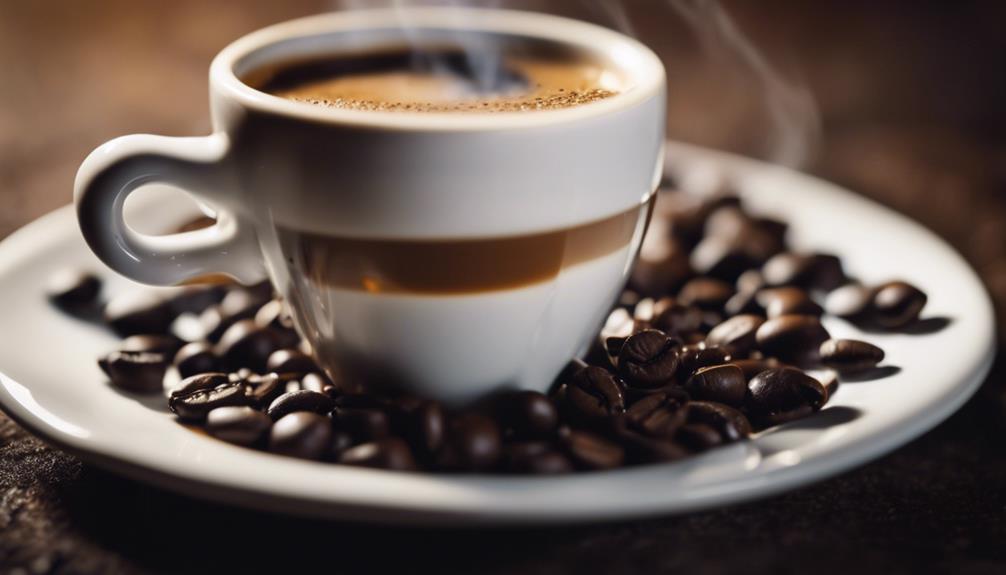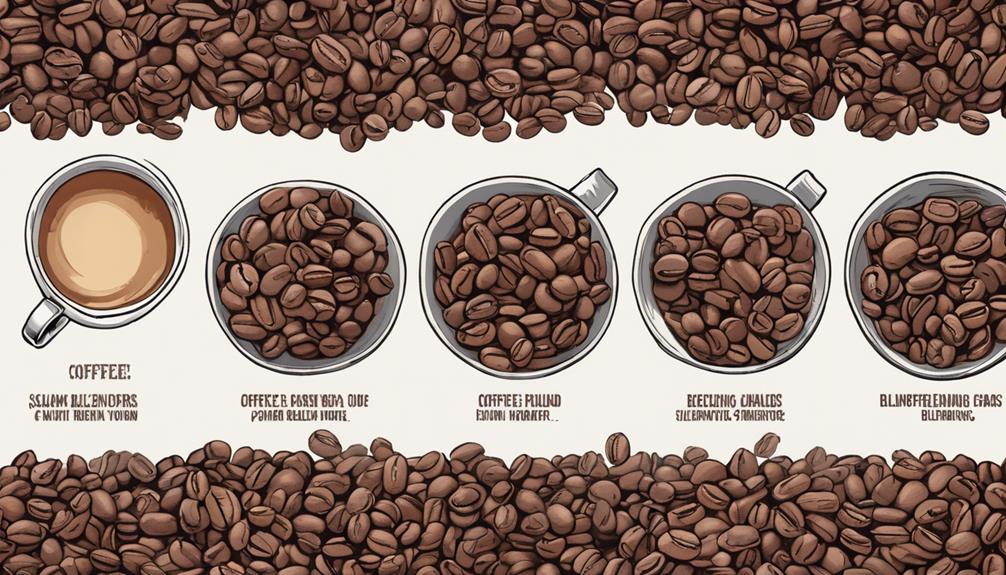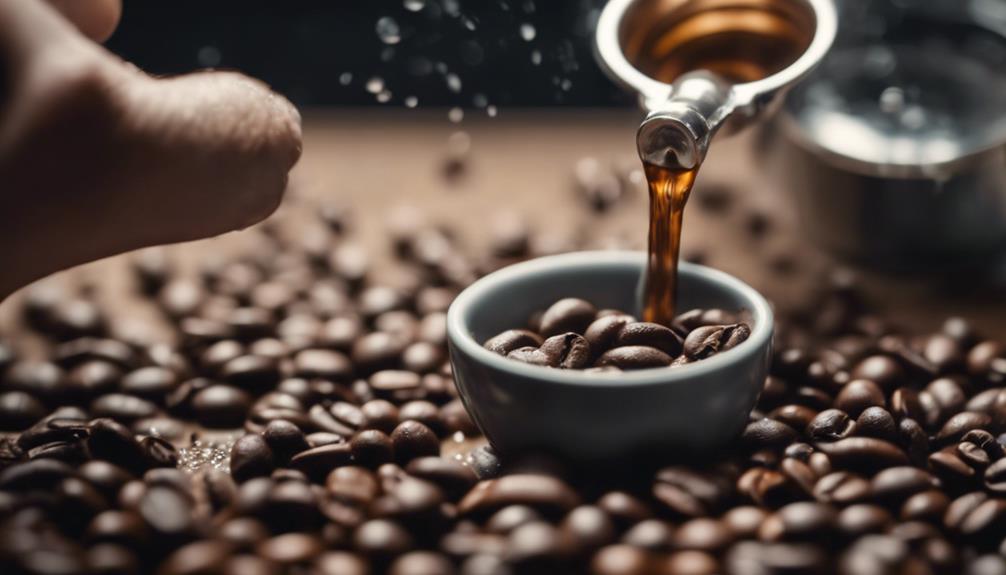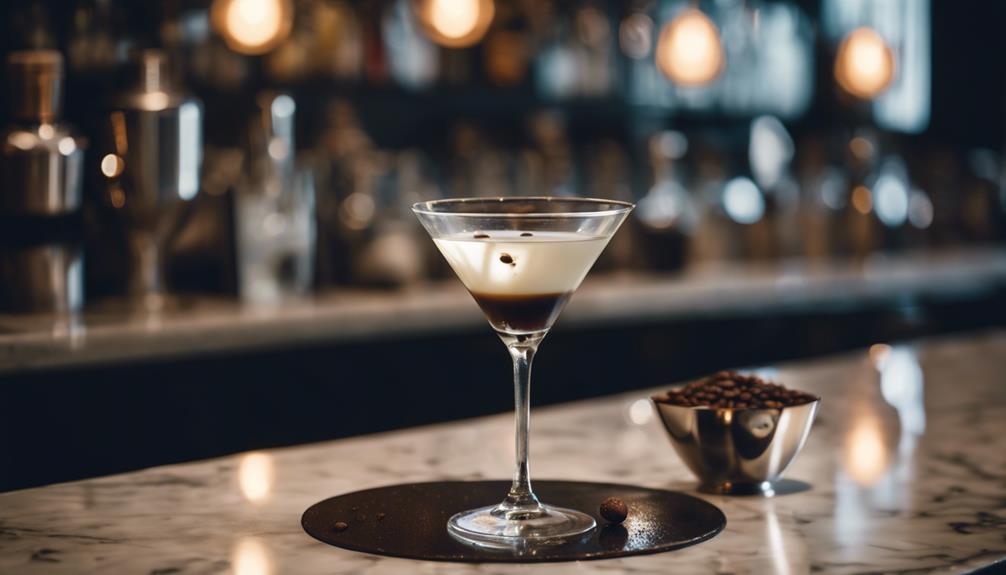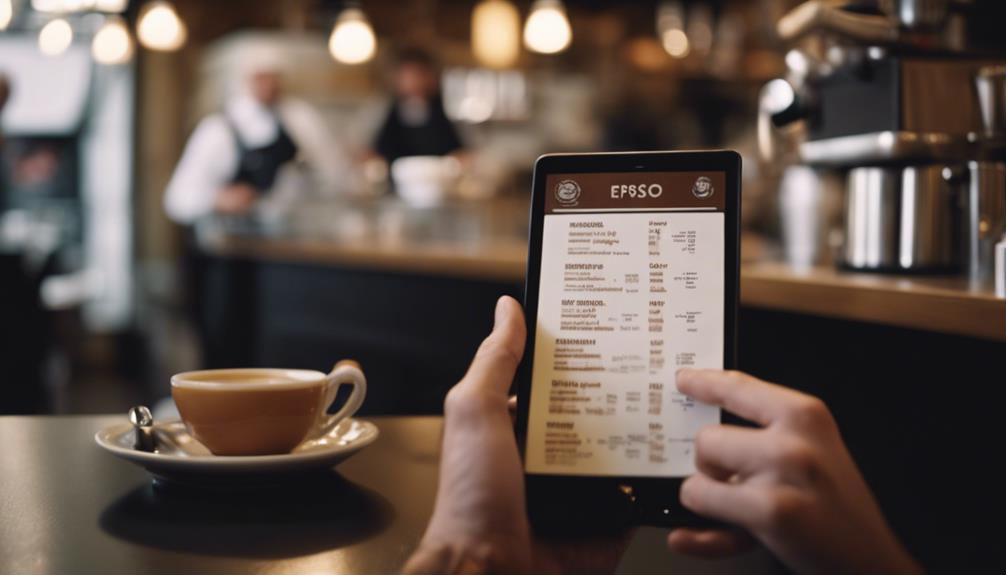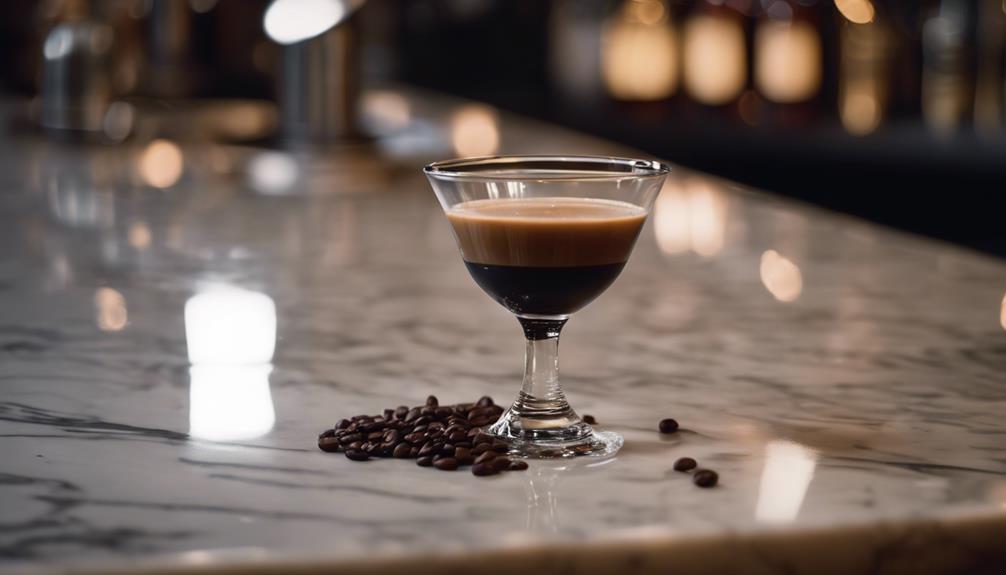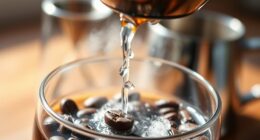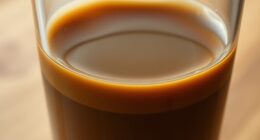You are on the brink of experiencing a jolt of energy from a small shot of espresso, with a standard 1-ounce serving containing approximately 63 milligrams of caffeine. And that’s not all – a double shot can have up to 125 milligrams, which is similar to a full cup of brewed coffee. The type of coffee beans, how they are roasted, and the brewing method all affect the caffeine content, making each shot a unique experience. The quick consumption of espresso leads to a rapid release of energy, intensified by the concentrated caffeine. However, there is more to discover – you are just one shot away from uncovering the surprising details behind your morning caffeine boost.
Key Takeaways
- A standard 1-ounce shot of espresso contains approximately 63 mg of caffeine, with double shots containing around 125 mg.
- Caffeine content in espresso can vary based on factors such as coffee beans, roast level, and brewing method.
- Espresso's concentrated caffeine triggers a rapid energy release due to quick consumption and smaller serving size.
- A single shot of espresso fits within the moderate consumption range, with healthy adults able to safely consume up to 400 mg of caffeine daily.
Caffeine Content in Espresso
When you opt for a standard 1-ounce shot of espresso, you can expect to get approximately 63 milligrams of caffeine, making it a highly concentrated source of caffeine compared to brewed coffee.
This amount of caffeine is remarkably high considering the small serving size, which is why espresso is often preferred by those who need a quick energy boost.
In comparison, an 8-ounce cup of brewed coffee typically contains around 96-128 milligrams of caffeine, highlighting the higher concentration of caffeine in espresso by volume.
If you opt for a double shot of espresso, also known as a doppio, you can expect to get around 125 milligrams of caffeine, which is nearly equivalent to a full cup of coffee.
The caffeine content in your shot of espresso can vary slightly depending on the type of coffee beans used, the roast level, and the brewing method employed by the espresso machine.
Factors Affecting Caffeine Levels
You might be surprised to learn that the caffeine content in your shot of espresso is influenced by several factors, including the type of coffee beans, roast level, grind size, brewing method, and amount of coffee used.
For instance, the type of coffee beans you use can greatly impact caffeine levels, as some beans naturally contain more caffeine than others. The roast type also plays a role, with darker roasts having slightly less caffeine due to the longer roasting process that breaks down caffeine.
The grind size of your coffee is also vital, as a finer grind increases the surface area, leading to enhanced caffeine extraction during brewing.
The brewing method and time, particularly the high pressure used in espresso preparation, maximize caffeine concentration compared to other methods like drip brewing.
Finally, the amount of coffee used in a shot of espresso can vary, but a standard single shot typically uses about 7-9 grams of coffee, which directly correlates to the caffeine level in the final product.
Perception of Caffeine Effects
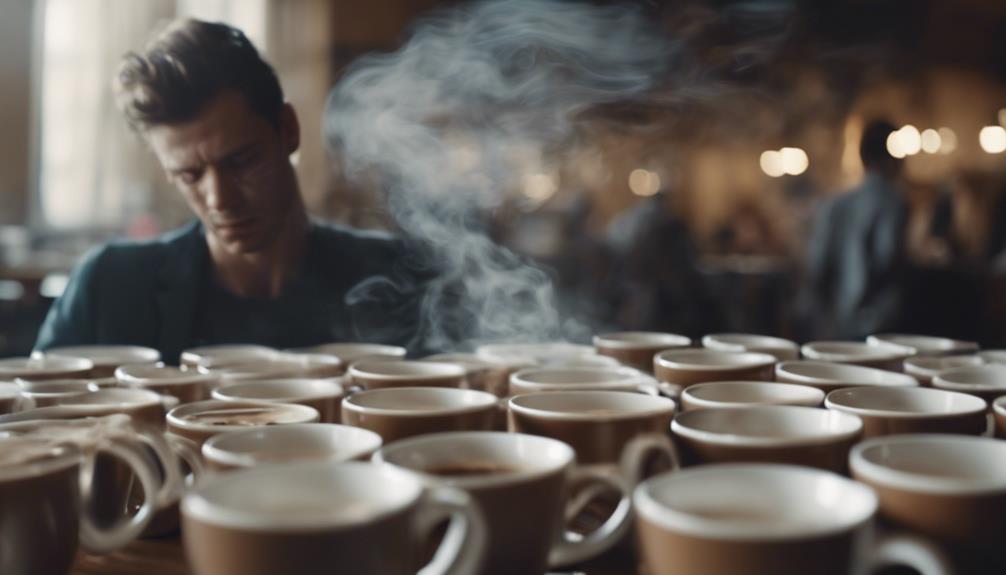
The concentrated nature of espresso shots, packed with approximately 63 milligrams of caffeine per ounce, triggers a rapid release of energy that can be intensely felt due to its speedy consumption. You might be surprised to know that the smaller serving size of espresso shots actually enhances the immediate perception of their stimulating effects compared to slower sipped regular coffee. It’s important to note that the caffeine content in espresso can vary depending on factors such as the type of coffee beans used and the brew method. Additionally, while the quick jolt of energy from espresso can be invigorating, it may also lead to a crash later on, making it important to consume in moderation. Understanding the caffeine content in espresso and its effects on the body can help individuals make informed choices about their coffee consumption.
| Factors Affecting Perception | Description |
|---|---|
| Individual Tolerance | Your tolerance to caffeine affects how you feel its effects |
| Psychological Expectation | You expect espresso to be stronger, so you feel it more |
| Preparation Method | Espresso's unique preparation method influences your perception |
| Serving Style | The way espresso is served contrasts with brewed coffee |
| Consumption Speed | You drink espresso quickly, making its effects feel more intense |
As you experience the quick energy boost from espresso, you might attribute it to the unique combination of these factors. Your perception of espresso's effects can be influenced by your individual tolerance to caffeine, as well as psychological factors like the expectation of a stronger effect. The preparation method and serving style of espresso also play a role in shaping your perception of its energizing impact.
Health Recommendations for Caffeine
As you consider your daily caffeine intake, you'll want to know the recommended limits to guarantee you're staying healthy.
You're probably wondering how much caffeine is too much, and what guidelines you should follow to reap the benefits while avoiding negative effects.
Safe Daily Limit
Healthy adults can safely consume up to 400 milligrams of caffeine daily, equivalent to about two to four 8-ounce cups of brewed coffee. This safe daily limit is set by the FDA, and it's crucial to stick to it to avoid unwanted side effects.
You might be wondering how this applies to your daily espresso habit. A single shot of espresso contains approximately 63 mg of caffeine, which is well within the moderate caffeine consumption range. As long as you're mindful of your overall caffeine intake, you can enjoy your espresso guilt-free.
Remember, moderate caffeine consumption is associated with enhanced mood, cognitive function, and even lower mortality rates. However, be cautious not to exceed the 400 mg mark, as consuming caffeine above this amount can lead to health risks like anxiety and sleep disturbances.
Caffeine Intake Guidelines
You're probably wondering what the guidelines are for caffeine intake, and how they impact your daily espresso habit. The good news is that moderate caffeine consumption, typically defined as 2 to 4 cups of coffee daily, is associated with enhanced mood and cognitive function. However, it's crucial to follow the caffeine intake guidelines to reap the health benefits.
| Category | Recommended Caffeine Intake | Equivalent Amount |
|---|---|---|
| Healthy Adults | 400 mg | 4 cups of regular coffee |
| Pregnant Individuals | 200 mg | 2-3 shots of espresso |
| Daily Limit | 500 mg | Above 4 cups of regular coffee |
| Single Shot | 63 mg | 1 shot of espresso |
As you can see, one shot of espresso contains approximately 63 mg of caffeine, allowing for precise consumption management. By sticking to the guidelines, you can enjoy the benefits of caffeine while minimizing the risks. Remember, consuming caffeine above 500 mg daily can lead to health risks such as anxiety, restlessness, and sleep disturbances. So, be mindful of your caffeine intake and make informed choices about your daily espresso habit.
Healthy Consumption Tips
To reap the benefits of caffeine while minimizing its risks, follow these guidelines to guarantee a healthy and balanced daily espresso habit.
As a general rule, you should limit your caffeine intake to 400 mg per day, equivalent to about two to four 8-ounce cups of brewed coffee. Since a single shot of espresso contains approximately 63 mg of caffeine, it's a controlled choice for monitoring your caffeine consumption.
If you're pregnant, be extra cautious and limit your caffeine intake to no more than 200 mg per day to reduce potential risks to fetal development.
Moderate caffeine consumption, including espresso, can enhance your mood and cognitive function without significant adverse effects. However, be mindful of your overall caffeine intake, as consuming above 500 mg per day can lead to health risks like anxiety, restlessness, and disrupted sleep patterns.
Coffee and Espresso Equipment
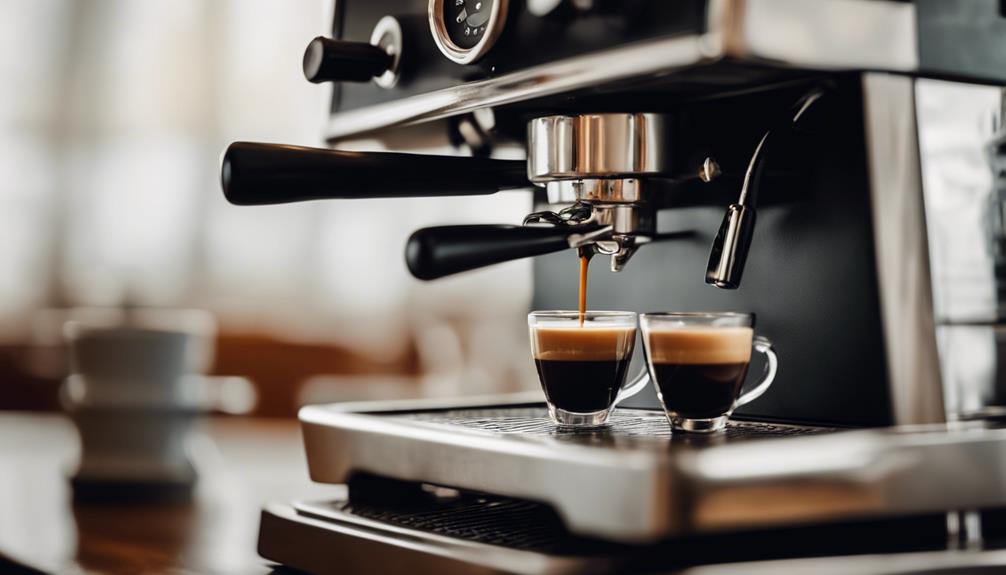
What sets quality espresso machines apart from the rest is their ability to precisely control brewing parameters, resulting in a superior flavor and aroma.
As a coffee enthusiast, you understand the importance of investing in the right equipment to perfect your espresso shot. When it comes to espresso machines, you have options ranging from traditional machines that operate at 9 bars of pressure to portable espresso makers that offer convenience on-the-go.
Here are three essential components to reflect on:
- Quality coffee grinders: A consistent fine grind is crucial for ideal espresso extraction and flavor.
- Espresso machines: Look for machines that can precisely control brewing parameters for a superior flavor and aroma.
- Portable espresso makers: These machines offer a convenient way to brew quality espresso anywhere, anytime.
Espresso Beans Vs. Coffee Beans
As you explore the world of espresso, you'll notice that the beans used can greatly impact the flavor and caffeine content of your shot.
You might wonder, what's the difference between espresso beans and coffee beans?
Let's break it down: the roast level, type of bean, and grind size all play a vital role in creating the perfect espresso.
Espresso Roast Levels
How do you choose between espresso beans and coffee beans when it comes to roast levels, and what impact does this have on your daily shot?
When it comes to espresso roast levels, you might be surprised to learn that darker roasts aren't just about flavor intensity, but also caffeine concentration.
Here are three key things to take into account when selecting your espresso beans:
- Dark roasts mean higher caffeine: Darker roasts have a more intense flavor and a higher caffeine concentration, making them perfect for those who need an extra boost.
- Flavor intensity varies: Lighter roasts have a more delicate flavor, while medium roasts offer a balance between flavor and caffeine. Dark roasts, on the other hand, have a bolder, richer taste.
- Espresso beans are roasted longer: Espresso beans are typically roasted longer than regular coffee beans, which enhances their distinct flavor and aroma.
When choosing your espresso beans, keep in mind that the roast level will impact the flavor and caffeine content of your daily shot.
Bean Type Matters
You may think that all coffee beans are created equal, but when it comes to espresso, the type of bean you use can greatly impact the flavor and caffeine content of your shot.
While espresso and regular coffee can be made from the same type of bean, the specifics of the roast and grind size considerably affect the final beverage's caffeine concentration.
Arabica beans, for instance, tend to have a lower caffeine content compared to Robusta beans.
When it comes to espresso, the type of bean used can make a considerable difference. Although espresso beans are often associated with higher caffeine levels, the actual caffeine content can vary based on the type of bean used.
Some beans naturally contain less caffeine than others, which can affect the overall caffeine content of your shot.
During the brewing process, the finer grind size of espresso beans allows for more efficient caffeine extraction, resulting in a more concentrated beverage.
Grind Size Importance
Fine-tuning the grind size of your espresso beans is vital, since it directly affects the caffeine extraction during brewing, resulting in a richer flavor and higher caffeine content per ounce.
When it comes to espresso, the grind size must be fine, similar to table salt, to maximize caffeine extraction. This is in contrast to regular coffee, which uses a coarser grind.
Here are three key points to keep in mind:
- Finer grind, more caffeine: A finer grind increases the surface area of the coffee, allowing for more efficient extraction of caffeine.
- Consistency is key: Consistent grind size is vital for uniform extraction; variations can result in under-extraction (sour taste) or over-extraction (bitter taste) in espresso.
- Espresso beans are unique: Espresso beans are typically roasted longer, which can affect their grind size and caffeine concentration, leading to a richer flavor and higher caffeine content per ounce.
Caffeine in Espresso-Based Drinks
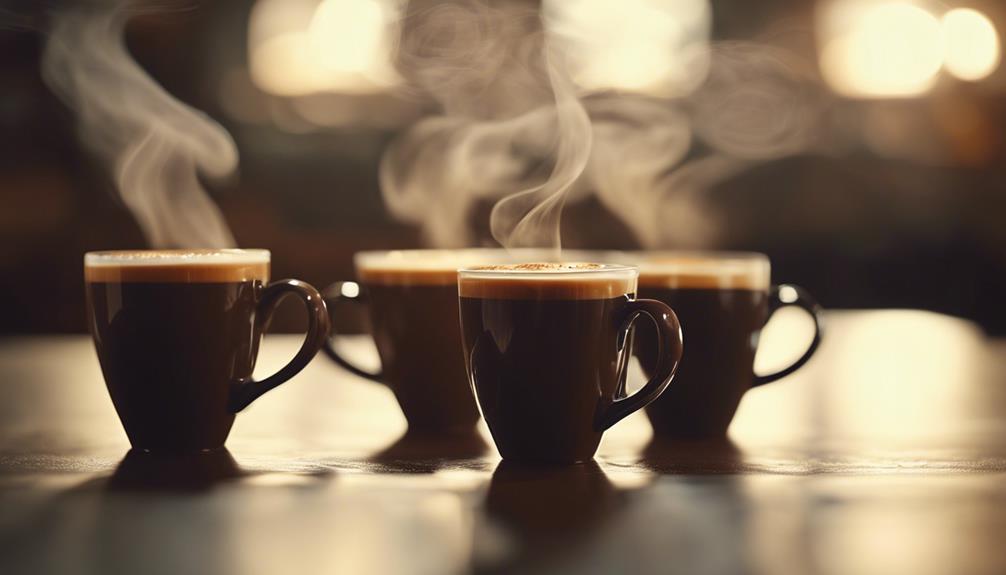
When you order an espresso-based drink, you're likely getting a significant dose of caffeine, especially if you opt for a latte or cappuccino, which typically contain two to three shots of espresso.
Since a single shot of espresso packs around 63-75 mg of caffeine, a medium-sized latte can deliver approximately 173 mg of caffeine. Cappuccinos follow a similar pattern, with a medium-sized drink containing around 173 mg of caffeine.
If you prefer Americano drinks, the caffeine content varies depending on the number of shots used, ranging from 75 mg for a short to 300 mg for a venti.
Mocha variations also have caffeine levels that depend on their size, with smaller drinks containing around 90 mg and larger venti sizes holding up to 180 mg, thanks to the addition of chocolate.
When you factor in the caffeine in espresso, it's clear that your daily coffee habit can add up quickly.
Brewing Techniques and Grind Size
To access the full potential of espresso's flavor and caffeine, it's important to master the brewing techniques and grind size that bring out the best in this concentrated coffee.
When it comes to brewing techniques, you'll want to pay attention to the grind size, brewing pressure, and brewing time. Here are three key takeaways to keep in mind:
- Grind size matters: Aim for a fine grind, similar to table salt, to guarantee ideal extraction of flavors and caffeine.
- Pressure and temperature count: Use around 9 bars of pressure and a water temperature of 190°F to 205°F to achieve the best flavor profile and caffeine output.
- Brewing time is significant: Aim for a brewing time of 25 to 30 seconds to allow for the perfect balance of flavor and caffeine extraction.
Using fresh coffee beans is also important, as it greatly enhances the flavor and aroma of your espresso.
Unraveling the Caffeine Mystery
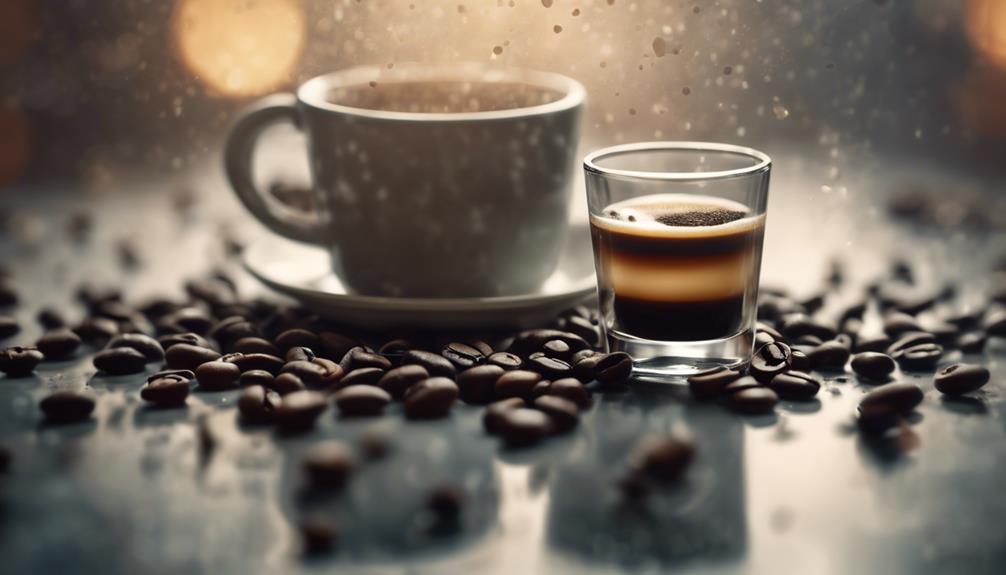
Revealing the secrets of espresso's caffeine content reveals a fascinating story, with a single 1-ounce shot packing a potent 63 mg of caffeine. You might think that's a lot, but it's actually a concentrated dose that's carefully crafted to give you a quick energy boost. However, it’s important to be mindful of the health risks of excessive espresso consumption, as consuming too much caffeine can lead to increased heart rate, anxiety, and insomnia. Moderation is key when it comes to enjoying the energizing benefits of espresso, and it’s always a good idea to consult with a healthcare professional if you have any concerns about your caffeine intake. Remember, a little kick of caffeine can be just what you need to power through your day, but too much of a good thing can have negative consequences.
The type of coffee bean, roast level, and grind size all play a role in determining the caffeine content of your shot. Finer grinds, for instance, yield more caffeine extraction.
Compared to brewed coffee, which averages around 12-16 mg of caffeine per ounce, espresso has a notably higher caffeine concentration. If you're feeling extra sluggish, a double shot (doppio) can provide an even more potent 125 mg of caffeine.
Because you typically drink espresso shots quickly, the caffeine hits your system fast, making its stimulating effects feel even more immediate.
As you unravel the mystery of espresso's caffeine content, you'll appreciate the precision that goes into crafting each shot to give you the perfect pick-me-up.
Frequently Asked Questions
How Much Caffeine Is in a Single Espresso Shot?
You're wondering how much caffeine is in a single espresso shot? Well, you'll get around 63 milligrams of caffeine in a standard 1-ounce shot, which is a pretty concentrated dose compared to brewed coffee! If you’re looking to compare the caffeine content in espresso to other beverages, a standard 8-ounce cup of brewed coffee typically contains around 95 milligrams of caffeine, while a 1-ounce shot of espresso contains approximately 63 milligrams. However, it’s important to keep in mind that the size and strength of espresso drinks can vary, so the caffeine content in espresso can fluctuate. Additionally, factors such as the type of coffee bean and the brewing process can also impact the caffeine content in espresso.
Is 2 Shots of Espresso a Lot of Caffeine?
You might think two shots of espresso is a lot, but it's actually moderate, equivalent to a standard cup of coffee, and within the safe daily limit of 400mg for healthy adults, unless you're particularly sensitive.
How Many Shots of Espresso Equal a Cup of Coffee?
You're wondering how many shots of espresso equal a cup of coffee? Well, to match the caffeine content, you'll need about 1.5 shots of espresso to equal one standard 8-ounce cup of brewed coffee!
Is 10 Shots of Espresso Too Much?
You're wondering if 10 shots of espresso is too much, and honestly, it's way over the limit. Consuming that many shots can lead to serious side effects like anxiety, restlessness, and disrupted sleep patterns.
Conclusion
As you wrap up your espresso-fueled journey, remember that the perfect shot is a delicate dance of beans, brewing, and technique.
The caffeine content may vary, but one thing's certain – a good espresso is a symphony of flavors that'll leave you humming.
So, the next time you savor that rich, bold flavor, recall the intricate harmony of factors that came together to create it, and let the caffeine coursing through your veins be the conductor of your daily rhythm.
